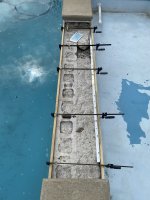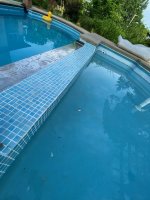Hi! We purchased a home in September of 2021 which came with a less than 10 year old Fiberglass Pool and Splash Pool. The Splash Pool drains into the main pool through 3 spillways. We live in Indiana and had a particularly hard winter. During some spring clean up we noticed that some of the front face of the splash pool had succumbed to the winter freeze and become dislodged. We contact a plaster repair person to repair the spot, and he pointed to the leaky tile around the spillways allowing water to get behind the plaster work.
This was an unexpected repair, and I would prefer to do it right so it will last. So I have a couple of questions:
1. How to repair the front face (under the spillways) properly? This area was originally tiled when the pool was installed, but the tile did not hold up to the Indiana winters. We plan to plaster with metal lath. and then stain and seal. Open to other ideas!

2. How to repair the spill ways. I have included pictures showing the rough fiberglass openings. I am open to re-skimming with concrete (not sure how to manage the transition from fiberglass to concrete), re-tiling (with some help on best practices for winter), or adding a custom stainless steel spillway that would run the entire length, with an apron in the splash pool ($390/each).
I appreciate any help you can offer, I would love to be better educated before hiring someone to do the work!




This was an unexpected repair, and I would prefer to do it right so it will last. So I have a couple of questions:
1. How to repair the front face (under the spillways) properly? This area was originally tiled when the pool was installed, but the tile did not hold up to the Indiana winters. We plan to plaster with metal lath. and then stain and seal. Open to other ideas!

2. How to repair the spill ways. I have included pictures showing the rough fiberglass openings. I am open to re-skimming with concrete (not sure how to manage the transition from fiberglass to concrete), re-tiling (with some help on best practices for winter), or adding a custom stainless steel spillway that would run the entire length, with an apron in the splash pool ($390/each).
I appreciate any help you can offer, I would love to be better educated before hiring someone to do the work!






 you on!
you on!








